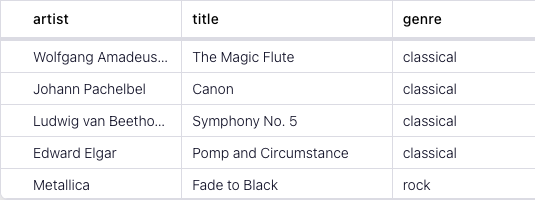How to merge two streams into one with Flink SQL
How to merge two streams into one with Flink SQL
Suppose that you have two Kafka topics containing songs of different genres and you wish to merge them into one. In this tutorial, we'll use Flink SQL to accomplish this task. We'll have an input topic containing rock songs, another input topic containing classical songs, and we'll populate an output topic containing all songs.
Setup
Let's assume the following DDL for our base rock_songs and classical_songs tables:
CREATE TABLE rock_songs (
artist STRING,
title STRING
);
CREATE TABLE classical_songs (
artist STRING,
title STRING
);Merge streams
Given the table definition above, we can create a merged table, and add a genre column, as follows:
CREATE TABLE all_songs (
artist STRING,
title STRING,
genre STRING
);
INSERT INTO all_songs
SELECT
artist,
title,
'rock' AS genre
FROM rock_songs;
INSERT INTO all_songs
SELECT
artist,
title,
'classical' AS genre
FROM classical_songs;Running the example
You can run the example backing this tutorial in one of three ways: a Flink Table API-based JUnit test, locally with the Flink SQL Client against Flink and Kafka running in Docker, or with Confluent Cloud.
Flink Table API-based test
Prerequisites
- Java 17, e.g., follow the OpenJDK installation instructions here if you don't have Java.
- Docker running via Docker Desktop or Docker Engine
Run the test
Clone the confluentinc/tutorials GitHub repository (if you haven't already) and navigate to the tutorials directory:
git clone git@github.com:confluentinc/tutorials.git
cd tutorialsRun the following command to execute FlinkSqlMergeTablesTest#testMerge:
./gradlew clean :merging:flinksql:testThe test starts Kafka and Schema Registry with Testcontainers, runs the Flink SQL commands above against a local Flink StreamExecutionEnvironment, and ensures that the routed results are what we expect.
Flink SQL Client CLI
Prerequisites
- Docker running via Docker Desktop or Docker Engine
- Docker Compose. Ensure that the command docker compose version succeeds.
Run the commands
Clone the confluentinc/tutorials GitHub repository (if you haven't already) and navigate to the tutorials directory:
git clone git@github.com:confluentinc/tutorials.git
cd tutorialsStart Flink and Kafka:
docker compose -f ./docker/docker-compose-flinksql.yml up -dNext, open the Flink SQL Client CLI:
docker exec -it flink-sql-client sql-client.shFinally, run following SQL statements to create the rock_songs and classical_songs tables backed by Kafka running in Docker, populate them with test data, and then create and populate a merged table containing all songs.
CREATE TABLE rock_songs (
artist STRING,
title STRING
) WITH (
'connector' = 'kafka',
'topic' = 'rock-songs',
'properties.bootstrap.servers' = 'broker:9092',
'scan.startup.mode' = 'earliest-offset',
'key.format' = 'avro-confluent',
'key.avro-confluent.url' = 'http://schema-registry:8081',
'key.fields' = 'artist;title',
'value.format' = 'avro-confluent',
'value.avro-confluent.url' = 'http://schema-registry:8081',
'value.fields-include' = 'ALL'
);INSERT INTO rock_songs VALUES
('Metallica', 'Fade to Black'),
('Smashing Pumpkins', 'Today'),
('Pink Floyd', 'Another Brick in the Wall'),
('Van Halen', 'Jump'),
('Led Zeppelin', 'Kashmir');CREATE TABLE classical_songs (
artist STRING,
title STRING
) WITH (
'connector' = 'kafka',
'topic' = 'classical-songs',
'properties.bootstrap.servers' = 'broker:9092',
'scan.startup.mode' = 'earliest-offset',
'key.format' = 'avro-confluent',
'key.avro-confluent.url' = 'http://schema-registry:8081',
'key.fields' = 'artist;title',
'value.format' = 'avro-confluent',
'value.avro-confluent.url' = 'http://schema-registry:8081',
'value.fields-include' = 'ALL'
);INSERT INTO classical_songs VALUES
('Wolfgang Amadeus Mozart', 'The Magic Flute'),
('Johann Pachelbel', 'Canon'),
('Ludwig van Beethoven', 'Symphony No. 5'),
('Edward Elgar', 'Pomp and Circumstance');CREATE TABLE all_songs (
artist STRING,
title STRING,
genre STRING
) WITH (
'connector' = 'kafka',
'topic' = 'all-songs',
'properties.bootstrap.servers' = 'broker:9092',
'scan.startup.mode' = 'earliest-offset',
'key.format' = 'avro-confluent',
'key.avro-confluent.url' = 'http://schema-registry:8081',
'key.fields' = 'artist;title',
'value.format' = 'avro-confluent',
'value.avro-confluent.url' = 'http://schema-registry:8081',
'value.fields-include' = 'ALL'
);INSERT INTO all_songs
SELECT
artist,
title,
'rock' AS genre
FROM rock_songs;INSERT INTO all_songs
SELECT
artist,
title,
'classical' AS genre
FROM classical_songs;SELECT * FROM all_songs;The query output should look like this:
artist title genre
Metallica Fade to Black rock
Smashing Pumpkins Today rock
Pink Floyd Another Brick in the Wall rock
Van Halen Jump rock
Led Zeppelin Kashmir rock
Wolfgang Amadeus Mozart The Magic Flute classical
Johann Pachelbel Canon classical
Ludwig van Beethoven Symphony No. 5 classical
Edward Elgar Pomp and Circumstance classicalWhen you are finished, clean up the containers used for this tutorial by running:
docker compose -f ./docker/docker-compose-flinksql.yml downConfluent Cloud
Prerequisites
- A Confluent Cloud account
- A Flink compute pool created in Confluent Cloud. Follow this quick start to create one.
Run the commands
In the Confluent Cloud Console, navigate to your environment and then click the Open SQL Workspace button for the compute pool that you have created.
Select the default catalog (Confluent Cloud environment) and database (Kafka cluster) to use with the dropdowns at the top right.
Finally, run following SQL statements to create the rock_songs and classical_songs tables, populate them with test data, and then create and populate a merged table containing all songs.
CREATE TABLE rock_songs (
artist STRING,
title STRING
);INSERT INTO rock_songs VALUES
('Metallica', 'Fade to Black'),
('Smashing Pumpkins', 'Today'),
('Pink Floyd', 'Another Brick in the Wall'),
('Van Halen', 'Jump'),
('Led Zeppelin', 'Kashmir');CREATE TABLE classical_songs (
artist STRING,
title STRING
);INSERT INTO classical_songs VALUES
('Wolfgang Amadeus Mozart', 'The Magic Flute'),
('Johann Pachelbel', 'Canon'),
('Ludwig van Beethoven', 'Symphony No. 5'),
('Edward Elgar', 'Pomp and Circumstance');CREATE TABLE all_songs (
artist STRING,
title STRING,
genre STRING
);INSERT INTO all_songs
SELECT
artist,
title,
'rock' AS genre
FROM rock_songs;INSERT INTO all_songs
SELECT
artist,
title,
'classical' AS genre
FROM classical_songs;Now query the merged table:
SELECT * FROM all_songs;The scrollable query output should start like this:

